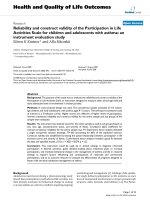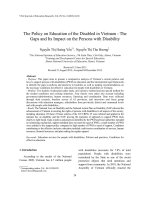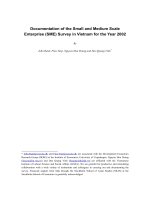Culture and entrepreneurship intention of the youth in vietnam
Bạn đang xem bản rút gọn của tài liệu. Xem và tải ngay bản đầy đủ của tài liệu tại đây (4.78 MB, 159 trang )
CULTURE AND ENTREPRENEURSHIP
INTENTION OF THE YOUTH IN VIETNAM
In Partial Fulfillment of the Requirements of the Degree of
MASTER OF BUSINESS ADMINISTRATION
In International Business
By
Ms. Hua Thi Ngoc Quyen
ID: MBA03026
International University - Vietnam National University HCMC
February, 2013
i
CULTURE AND ENTREPRENEURSHIP INTENTION OF THE YOUTH IN VIETNAM
In Partial Fulfillment of the Requirements of the Degree of
MASTER OF BUSINESS ADMINISTRATION
In International Business
by
Ms. Hua Thi Ngoc Quyen
ID : MBA03026
International University - Vietnam National University HCMC
February, 2013
Under the guidance and approval of the committee, and approved by all its members, this thesis
has been accepted in partial fulfillment of the requirements for the degree.
Approved:
---------------------------------------------Chairperson
---------------------------------------------Committee member
---------------------------------------------Committee member
--------------------------------------------Committee member
--------------------------------------------Committee member
--------------------------------------------Committee member
ii
Acknowledgement
To complete this thesis, I have been benefited from the following people…
At first, I am heartily thankful to my supervisor, Doctor Nguyen Quynh Mai, whose guidance
and support from the initial to the final level that enabled me to accomplish this research.
Without her whole-hearted instructions and supports, I hardly overcome the obstacles during
research process. She not only shows me how to conduct a real and meaningful research but also
inspire me to keep studying.
My sincere thanks also go to my two specially friends, ―Vu and Vu‖, who always give me timely
advices and helpful supports during the time research being carried out.
I would like to thank to all those professors in School of business for helping in revising
questionnaires and many academic advices. My appreciation is also expressed to the fervor
support from school‘s student affair.
Last, I want to show my deep gratitude to my family, especially my mother, for giving birth to
me, encouraging and supporting me throughout of my life.
i
Plagiarism Statements
I would like to declare that, apart from the acknowledged references, this thesis either
does not use language, ideas, or other original material from anyone; or has not been previously
submitted to any other educational and research programs or institutions. I fully understand that
any writings in this thesis contradicted to the above statement will automatically lead to the
rejection from the MBA program at the International University – Vietnam National University
Ho Chi Minh City.
ii
Copyright Statement
This copy of the thesis has been supplied on condition that anyone who consults it is
understood to recognize that its copyright rests with its author and that no quotation from the
thesis and no information derived from it may be published without the author‘s prior consent.
© Hua Thi Ngoc Quyen/ MBA03026 / 2013
\
iii
Contents
LIST OF TABLES ............................................................................................................................... viii
LIST OF FIGURES ................................................................................................................................ xi
Abbreviations ....................................................................................................................................... xiii
Abstract................................................................................................................................................ xiv
CHAPTER 1: INTRODUCTION ......................................................................................................... 1
1.
Research background ................................................................................................................... 1
2.
Rationale ..................................................................................................................................... 2
3.
Entrepreneurship in Vietnam ........................................................................................................ 3
4.
Problem statement........................................................................................................................ 7
5.
Research Objectives ..................................................................................................................... 8
6.
Research methodology ................................................................................................................. 8
7.
Research scope ............................................................................................................................ 8
8.
Significance ................................................................................................................................. 8
9.
Research structure ........................................................................................................................ 9
CHAPTER 02: LITERATURE REVIEW .......................................................................................... 11
1.
Entrepreneurship ........................................................................................................................ 11
1.1.
What is entrepreneurship? .................................................................................................. 11
1.2.
Dimensions of entrepreneurship intention ........................................................................... 11
2.
Culture....................................................................................................................................... 12
3.
Vietnam National Culture .......................................................................................................... 16
4.
Factors influence entrepreneurship ............................................................................................. 23
4.1.
Personal traits ..................................................................................................................... 23
iv
4.2.
Needs and Motives ............................................................................................................. 27
4.3.
Environment Context ......................................................................................................... 31
CHAPTER 03: RESEARCH METHODOLOGY .............................................................................. 34
1.
Conceptual framework and hypotheses....................................................................................... 34
2.
Research Procedure.................................................................................................................... 36
3.
Measurement ............................................................................................................................. 36
4.
Semi – structure interview.......................................................................................................... 41
4.1.
Interviewer ......................................................................................................................... 41
The interview protocol is attached in Appendix B .............................................................................. 41
4.2.
5.
6.
7.
Outcome of Semi-Structure interview ................................................................................. 42
Draft questionnaire .................................................................................................................... 42
5.1.
Questionnaire design .......................................................................................................... 42
5.2.
Pilot questionnaire .............................................................................................................. 43
Data collection method .............................................................................................................. 43
6.1.
Sample ............................................................................................................................... 43
6.2.
Sampling design ................................................................................................................. 44
Data analysis method ................................................................................................................. 44
7.1.
Descriptive statistics ........................................................................................................... 44
7.2.
Factor analysis and reliability test ....................................................................................... 45
7.3.
Testing model with Structural Equational Modelling (SEM) ............................................... 48
CHAPTER 04: DATA ANALYSIS – FINDINGS .............................................................................. 49
1. Introduction ................................................................................................................................... 49
2. Sample demographic...................................................................................................................... 49
v
3. Descriptive statistics ...................................................................................................................... 51
3.1. Dependent factor (Entrepreneurship intention) ........................................................................ 51
3.2. Independent factors ................................................................................................................. 51
4. Exploratory factor analysis (EFA) and Reliability test using Cronbach‘s alpha ............................... 59
4.1. EFA for individual scale.......................................................................................................... 59
4.2. EFA for all factor scales together ............................................................................................ 68
5. Confirmary factor analysis (CFA) .................................................................................................. 74
5.1 CFA of factor Entrepreneurship intention. ................................................................................ 74
5.2. CFA of all independents constructs ............................................................................................. 75
6. Model and hypotheses modification ............................................................................................... 83
7. Testing research model using SEM ................................................................................................ 85
CHAPTER 5: DISCUSSION, RECOMMENDATION, AND CONCLUSION ................................. 85
1. Discussion ..................................................................................................................................... 85
1.1. The relationships between Confucian work ethics and other factors ......................................... 85
1.2. The relationships between Family culture value and other factors. ........................................... 87
1.3. The correlation between Motives and Personal traits................................................................ 88
1.4. The influence of Confucian work ethics on Entrepreneurship intention. ................................... 88
2. Limitations and Recommendations ................................................................................................ 90
3. Conclusion .................................................................................................................................... 90
REFERENCE LIST ............................................................................................................................... 91
APPENDIXES ...................................................................................................................................... 95
APPENDIX A: ENTREPRENEURIAL READINESS QUESTIONNAIRE ....................................... 95
APPENDIX B: SEMI-STRUCTURED INTERVIEW PROTOCOL................................................... 97
vi
APPENDIX C: RESEARCH SURVEY ........................................................................................... 104
APPENDIX D: EXPLORATORY FACTOR ANALSYS (ALL FACTORS) ................................... 110
APPENDIX E: NORMALITY ASSESSMENT ............................................................................... 125
APPENDIX F: REGRESSION WEIGHT AND STANDARDIZED REGRESSION WEIGHT OF FINAL
CONSTRUCT MODEL ...................................................................................................................... 126
APPENDIX G: MODIFICATION INDICES OF FOR ADJUSTMENT OF FINAL MODEL .............. 128
vii
LIST OF TABLES
Table 1: The mainstreams of entrepreneurial research (Chu 1998:9)............................................. 1
Table 2: Enterprise category ........................................................................................................... 4
Table 3: Number of SMEs categoried by labor scale ..................................................................... 5
Table 4: Characteristics and attributes of entrepreneurs (cited from Turan & Kara, 2007) ......... 24
Table 5: Traits of entrepreneurs (cited from Pendergast , 2004) .................................................. 24
Table 6: Entrepreneurship entry motives (cited from Basu & Altinay , 2002)............................. 29
Table 7: Research hypotheses ....................................................................................................... 35
Table 8: Measurements ................................................................................................................. 37
Table 9: Model fit indices ............................................................................................................. 47
Table 10: Entrepreneurship intention descriptive statistics .......................................................... 51
Table 11: National culture descriptive statistics ........................................................................... 52
Table 12: Personal traits descriptive statistics .............................................................................. 54
Table 13: Motives descriptive statistics ........................................................................................ 56
Table 14: Environment descriptive statistics ................................................................................ 58
Table 15: Total Variance Explained of factor EP intention .......................................................... 59
Table 16: RELIABILITY TEST ................................................................................................... 59
Table 17: Item elimination process of factor National culture ..................................................... 60
Table 18: Rotated Component Matrix .......................................................................................... 61
Table 19: RELIABILITY TEST of Culture subconstructs ........................................................... 61
Table 20: Remained cultural subconstructs for next EFA ............................................................ 62
Table 21: Item elimination process of factor Personal traits ........................................................ 63
Table 22: Rotated Component Matrix of factor Personal traits .................................................... 64
Table 23: Reliability test of subconstructs factor Personal traits .................................................. 64
viii
Table 24: Item elimination process of factor Motives .................................................................. 65
Table 25: Rotated Component Matrix of factor Motives.............................................................. 66
Table 26: Reliability test of subconstructs factor Motives ........................................................... 66
Table 27: Remained items of Motive factor for next EFA ........................................................... 67
Table 28: Item elimination process of Factor Environment ......................................................... 67
Table 29: Rotated Component Matrix of factor Environment ...................................................... 68
Table 30: Reliability test for subconstructs of factor Environment .............................................. 68
Table 31: Sum of items for next EFA ........................................................................................... 69
Table 32: Item elimination process ............................................................................................... 70
Table 33: Rotated Pattern Matrix of All Scale Together .............................................................. 70
Table 34: Sub-constructs and their names .................................................................................... 72
Table 35: Reliability test for new-formed sub-constructs............................................................. 73
Table 36: HOELTER index .......................................................................................................... 75
Table 37: Fitness indices of construct model ................................................................................ 76
Table 38: Composite reliability and extracted variance of each construct ................................... 78
Table 39: Composite reliability and extracted variance of each construct ................................... 79
Table 40: Reliability using Cronbach's alpha ............................................................................... 80
Table 41: Correlation calculation and estimation ......................................................................... 80
Table 42: Modified hypotheses ..................................................................................................... 83
Table 43: Fit indices of model phase 1 ......................................................................................... 85
Table 44: Regression Weights of model phase 1 .......................................................................... 74
Table 45: Standardize regression weight of model phase 1 .......................................................... 74
Table 46: Fit indices of model testing phase 2 ............................................................................. 75
Table 47: Regression weight of model phase 2 (version 1) .......................................................... 77
ix
Table 48: Standardized Regression Weights of model phase 2 (version 1) ................................. 77
Table 49: Covariances between Personal traits and Motives........................................................ 78
Table 50: Correlations between Personal traits and motives ........................................................ 78
Table 51: Regression weight of modified model .......................................................................... 80
Table 52: Fit indices of second time modified model................................................................... 82
Table 53: Fitness indices of Final model ...................................................................................... 82
Table 54: Result of hypotheses testing ......................................................................................... 84
x
LIST OF FIGURES
Figure 1 : Number of enterprises registered annually (source GSO) .............................................. 4
Figure 2: Number of active enterprises in term labor scale on 1 Jan 2010 ..................................... 5
Figure 3: Number of SMEs categoried by sector (source GSO) .................................................... 6
Figure 4: Recommended theoretical model by Phan Truong Giang (2011) ................................... 7
Figure 5: Geert Hoftede‘s five cultural dimensions ...................................................................... 14
Figure 6: A model of Culture's Assciation with Entrepreneurship ............................................... 31
Figure 7: Conceptual model .......................................................................................................... 34
Figure 8: Research procedure ....................................................................................................... 36
Figure 9: Respondent' current job ................................................................................................. 49
Figure 10: Respondent's education level ...................................................................................... 49
Figure 11: Respondent's desire job ............................................................................................... 50
Figure 12: Questionnaire responses on national culture ............................................................... 53
Figure 13: Questionnaire responses on personal traits ................................................................. 55
Figure 14: Questionnaire responses on Motives ........................................................................... 57
Figure 15: Questionnaire responses on environment factor ......................................................... 58
Figure 16: single construct model of EP intention factor (version 1) ........................................... 74
Figure 17: Single construct model of EP intention factor............................................................. 75
Figure 18: Construct model (version 1) ........................................................................................ 77
Figure 19: Construct model (final version) ................................................................................... 82
Figure 20: Research model modification ...................................................................................... 83
Figure 21: Model phase 1 ............................................................................................................. 73
Figure 22: Model testing phase 2 .................................................................................................. 76
xi
Figure 23: First time modified model ........................................................................................... 79
Figure 24: Second time modified model ....................................................................................... 81
Figure 25: Final model .................................................................................................................. 83
Figure 26: Simplified model ......................................................................................................... 89
xii
Abbreviations
CFA
Confirmary Factor Analysis
EFA
Exploratory Factor Analysis
EP
Entrepreneurship
GSO
General Statistic Office
KMO
Kaiser – Meyer – Olkin index
SEM
Structural Equational Modelling
SMEs
Small and Medium Enterprises
xiii
Abstract
Entrepreneurship is considered as the main source of economic development, poverty reduction
and job creation. There are many researches on the world has been studied this field for long
time, however, the concept of entrepreneurship seem to be fresh for Vietnamese scholar since
there is very limited number of research studying on Vietnamese entrepreneurship. There are
varieties of approach for studying entrepreneurship, this research has been conducted on the
cultural perspective to see how Vietnam national culture has influence on new business start-ups
of young people living in Ho Chi Minh city.
The research is based on previous qualitative study of Phan (2011) which has been located the
prominent and typical values of Vietnamese people. To continue, the quantitative research is
needed to identify the causal relationship between national culture and entrepreneurship of
youth. From the literature review, the relationship is formed with more three added moderate
factors including personal traits, motives, and environmental context.
A sample of 447 people including students, office staffs, and young entrepreneurs who are from
18 to 35 years old participated in research survey. Semi structure interview is employed for the
measurement formation and questionnaire design. Convinience and snowball samplings are used
for data collection. The technique of structural equational modeling is applied to identify the
causal relationships among factors.
The findings show that entrepreneurship intention of young people originates from the personal
traits which are influenced by Confucian work ethics, family culture values and personal
motivations. Confucian work ethics has no direct effect on entrepreneurship but it underlies and
directs the common thoughts and behaviors of Vietnamese people including starting a new
venture. The research is failed to identify the relationship between external environment and
entrepreneurship, therefore, it is suggested for the further study should have long term
perspective
to
see
the
effect
of
environment
on
new
firm
formation.
xiv
15
CHAPTER 1: INTRODUCTION
1. Research background
A considerable amount of literature conducted over the past decades has shown that
entrepreneurship has emerged as an important field of study among researchers and
policy makers who have been interested in understanding the factors affecting
entrepreneurial activity (Mueller & Thomas, 2000a). The word ―entrepreneur‖ is derived
from a French root ―entreprendre‖, meaning to ―undertake‖. The term ―entrepreneur‖
seems to have been introduced into economic theory by Cantillon (1755) but Say (1803)
first accorded the entrepreneur prominence (Kruger, 2004). However, Schumpeter is
known as the one who initiated in the field of entrepreneurship by associating it clearly
with innovation. This Austrian economist‘s ideas help establish entrepreneurship as a
substantive area of historian‘s endeavors by linking entrepreneurship to a theory of
economic change (Jones & Wadhwani, 2007).
Entrepreneurship occurs at significantly higher rates than at any time in the last 100
years (Gartner & Shane, 1995). From research perspective, there are numerous studies
investigating business start-up from both sides, supply and demand. The supply-side
school concentrates on the characteristics of entrepreneurs. On the other hand, the
demand-side school focuses on the environmental basis of organization formation. From
subject-area approach, the study of entrepreneurs can be conducted under one or
combination of the four dimensions stream as compiled and summarized in table 1.1
(Chu, 1998) below.
Table 1: The mainstreams of entrepreneurial research (Chu 1998:9)
Mainstreams
Psychological:
Traits and
Research Subjects
Entrepreneurs‘
characteristics
Line of Inquiry
and Causes (Why)
entrepreneurial process
behavioral
Sociological:
Social and cultural
Entrepreneurs of different social and Causes (Why)
cultural backgrounds
1
Economics
Relationship
between
economic Effects (What)
environment and entrepreneurship
Management
Entrepreneurs‘ skill, management and Behavior (How)
growth
2. Rationale
In recent decades, historians have increasingly sought to ground the study of how culture
and nationality affect entrepreneurship by examining how specific social structures and
relationships shape the influence of entrepreneurial culture (Jones, G. & Wadhwani R.D.,
2007). Landes (1953) said that culture was a consistent determinant of the supply of
entrepreneurship and hence of long-term economic growth. For over half a century, he
has kept stressing the importance of national cultural factors, values, and social attitudes
in explaining the growth of entrepreneurial activity (1969, 1999, 2003). Sawyer (1954)
with the same argument has show that the persistence of Puritan values and the frontier
spirit in American society have a strong support for new business formation in the United
States. Davidson (1997) conducted a research on 6 regions of Swenden to identify the
influence of culture on different new firm formation rate across regions. They concluded
that cultural values and beliefs have a small but statically significant association with
regional rates of new firm formation. Lee and Peterson (2000) suggested that only
countries with a culture that is favorable to entrepreneurship are able to generate a strong
entrepreneurial, leading to the development of entrepreneurial activity and the increase of
global competitiveness.
Many researchers try to identify personal characteristics distinguishing entrepreneurs and
non-entrepreneurs (Bolton & Thompson, 2004; Shane, 2003; McClelland, 1961). Several
researches which are based on five cultural dimensions of Geert Hoftede have pinpointed
that cultural values have effects on entrepreneur‘s characteristics and motives
(Scheinberg&MacMillan 1998; McGrath et al 1992b; Mueller & Thomas 2000; Thomas
& Mueller 2000).
Chan K. L, Sivapalan S., and Bahiyah A H (2009) conducted a research focusing on
entrepreneurship of young people (from 25 to 40 years old) in Malaysia. The study result
2
has show that not only sociological environment like religious particularity, cultural
values but also variety of business attributes such as willingness to take risk, to work
hard, to continually learn, and to be undaunted by challenges has influence on new
business star-ups of youth in Malaysia. The research also compared the different
characteristics between male and female entrepreneurs.
However, social-cultural approach has been widely critiqued. Gerschenkron (1962b,
1966) was strongly disagreed about the role of national culture and norm as a determinant
of national entrepreneurship. He argued that the statics and rigidity of national culture
make it impossible to totally account for the dynamic nature of entrepreneurial activity.
He also figured out the social-cultural perspective had missed Schumpeter‘s basic
premise the entrepreneurs often acted as agents of change rather than as captives of their
environment (cited in Jones&Wadhwani, 2007).
On the other hand, Hayton, George and Zahra (2002) argued that culture is as ―a
moderator of the relationship between contextual factors and entrepreneurial outcomes‖.
They believed that ―cultural characteristics transform and complement the institutional
and economic contexts to influence entrepreneurship‖. Moreover, they said ―culture is
not the only one moderator of the relationship between new business formation and
economic and institutional contexts‖. There are some other moderators such as need and
motives, beliefs and behaviors, and cognition of entrepreneurs which should be included
in studying entrepreneurship.
3. Entrepreneurship in Vietnam
In Vietnam, the Doi moi (renovation) policy in 1986 coupled with the passage of the
Enterprise Law in 2000 has stimulated a tremendous growth of small – and medium –
sized enterprises (SMEs), which are considered an important vehicle for the economic
growth in Vietnam. Since then, there has been a phenomenal transition to a marketoriented model, in which entrepreneurship has broadly become a universal modality for
people wishing to become gloriously rich. For the last decade, the number of newly
established enterprises has increased dramatically. The new business formation rate was
3
to
be
about
6
times
larger
in
2010
compared
with
one
in
2000
84,531 84,000
65,319
58,196
48,959
46,744
37,306 39,958
14,453
19,642 21,668
27,774
Figure 1 : Number of enterprises registered annually (source GSO)
Under Decree No.56/2009/ND-CP of the Government on June 30, 2009 on assistance to
the development of SME, micro enterprise, small enterprise, and medium enterprise are
defined based on labor scale, capital and economic sector as follow:
Table 2: Enterprise category
Micro
enterprises
Small enterprise
Medium enterprises
SECTOR
Number of
laborers
Total capital
Number of
laborers
Total capital
Number of
laborers
Agriculture,
forestry and
fishery
<=10
<= VND 20
billion
From 10 to
200
From VND
20 - 100
billion
From 200 300
Industry and
Construction
<=10
<= VND 20
billion
From 10 to
200
From VND
20 - 100
billion
From 200 300
Trade and
Service
<=10
<= VND 10
billion
From 10 to 50
From VND
10 - 50
billion
From 50 - 100
Source: GSO
4
In term of labor scale, there are 248,842 active enterprises on 1 January 2010. Number of
micro-, small-, and medium enterprise accounted for 97.43%. During 2000 – 2009, micro
enterprise sector achieved the highest average growth rate of 24.7% per annum in term of
number, while the average growth rate of small, medium and large enterprises are
20.41%, 11.79% and 7.28%, respectively.
2% 3%
Micro enterprise
Small enterprise
30%
Medium enterprise
Large enterprise
65%
Figure 2: Number of active enterprises in term labor scale on 1 Jan 2010
(Source GSO)
Proportion of micro, small, medium and large enterprises widely varied among economic
sector, including private sector, state-owned and foreign invested one. In private sector,
micro, small and medium-sized enterprises took the largest proportion, of 98.54%, and
accounted for 94.61 % of total active enterprises in Vietnam.
Table 3: Number of SMEs categoried by labor scale
Labor Scale
Total
Micro
Small
Medium
Large
enterprises
enterprises
enterprises
enterprises
248,842
162,785
74,685
5,010
6,389
100%
65%
30%
2%
3%
Total
5
3,364
69
1,260
570
1,465
1%
2%
37%
17%
44%
238,932
161,661
69,918
3,857
3,496
96%
68%
29%
2%
1%
6,546
1,055
3,480
583
1,428
3%
16%
53%
9%
22%
State-owned sector
Non-state sector
Foreign invested sector
Source: GSO
During 2000-2009, new SMEs can be positioned as a king in job creation. While 59% of
total employment in business sector working for state-owned companies in 2000, ten
years later, when number of laborers increased to 8,927,900; 59% of them working in
small and medium enterprises of non-state sector, contribute over 40% to the Gross
Domestic Products (GDP). According to the General Statistic Office (GSO), in the first
half of the year 2012, more than 36,100 new businesses were added with a total
registered capital of VND232.5 trillion.
-
2,000,000
4,000,000
6,000,000
8,000,000
10,000,000
2000
2001
2002
2003
2004
2005
2006
2007
2008
2009
State-owned sector
Non-state sector
Foreign invested sector
Figure 3: Number of SMEs categoried by sector (source GSO)
6
Through the statistic numbers presented above, it is abundantly clear that
entrepreneurship can be considered as a driving force of the economic growth,
innovation and employment in Vietnam. Because of those significant roles, Vietnamese
entrepreneurship should be paid much more attention and higher consideration by
scholars and governors in order to enforce the economy and assist entrepreneurs to
overcome the challenges of globalization era.
4. Problem statement
This research inherits the findings of (Phan, 2011) who took the first step on studying
how cultural factors have influence on business start-ups of Vietnamese youth, his
works are served as an exploratory stage for further studying about the impact of culture
on entrepreneurship in Vietnam. By exercising qualitative approach, Phan used narrative
method which employed the story – telling strategy, the content of stories collected from
interviewees who are scholars and entrepreneurs are analyzed, coded, and categorized.
Phan drawn a conclusion that there are two factors that haves effect on entrepreneurship
of youth in Vietnam. These are cultural factors (includes parental influence,
sentimentalism, social orders, collectivism and sharing knowledge); and personal traits
(includes risk propensity, perseverance, passion, creativity and opportunity recognition).
However, whether there is a relationship between these factors was not mentioned, and
how they influence on entrepreneurship on young people in Vietnam has not been
identified.
Cultural factors:
Personality traits:
• Parental influences
• Sentimentalism
• Social orders
• Collectivism
• Sharing knowledge
• Risk propensity
• Perseverance
• Passion
• Creativity
• Opportunity recognition
Entrepreneurship
Figure 4: Recommended theoretical model by Phan Truong Giang (2011)
7
This research aims to continue fulfilling a set of socio-cultural factors that have
influence on the decision of being self – employment of Vietnamese youth. It is also set
to determine the relationship among these factors and between them with the
entrepreneurship. Therefore, its findings will serve as base for further academic
researches on business start-ups in Vietnam; and provide direction for policy makers
who can generate appropriate regulations to flourish the entrepreneurship of young
people in Vietnam.
In general, this research tries to answer the questions that what socio-cultural factors
influence young individual’s decision to switch from either paid work or
unemployment to self – employment, and the relationship among those factors?
5. Research Objectives
To develop the conceptual framework demonstrating relationships among factors/
determinants and between them with entrepreneurship of youth in Vietnam.
To determine the effect intensity of various factors on entrepreneurship of young
people in Vietnam
6. Research methodology
Utilizing the findings from exploratory research of Phan (2010) combined with literature
review, the conceptual framework will be built. Primary data for this research comes
from a questionnaire survey of university students, office staffs and entrepreneurs in Ho
Chi Minh City. The model is tested by using the method of structural equation modeling
on the sample of 447 cases. The research procedure and method will be described in
detail in part three of this paper.
7. Research scope
This research is implemented within Ho Chi Minh City, and focus on population that
includes undergraduate students, office staffs and entrepreneurs from 18 to 35 years old.
8. Significance
Vietnamese people are young and entrepreneurial in spirit, they love to be self –
employment. The number of new established enterprise increases remarkably year by
8









